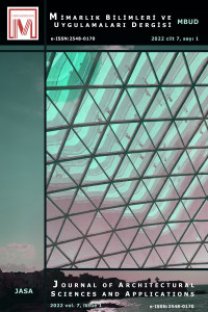The Place of Ekphrasis in the Formation of Architectural Narrative
Ekfrasis, mimari anlatı, mimari çizim, mimari temsil
The Place of Ekphrasis in the Formation of Architectural Narrative
___
- Abbott, H. P. (2006). Narrative and Life. In The Cambridge Introduction to Narrative (pp. 1-11). (7th printing). Cambridge, New York: Cambridge University Press.
- Ağıl, N. (2015). Ekfrasis: Batı’da ve Bizde Görsel Sanatın Sözlü Tasviri. İstanbul: Simurg Yayınları.
- Alemdar, Z. Y. & Aydınlı, S. (2011). Mimarlıkta anlatı olarak imge. İTÜ Dergisi/d Mimarlık, Planlama, Tasarım. 10(1), 83-94.
- Becker, A. S. (1995). The Shield of Achilles and the Poetics of Ekpharsis. Rowman & Littlefield Publishers.
- Benton, M. (1997). Anyone for Ekphrasis. British Journal of Aesthetics. 37(4), 367-376.
- Coates, N. (2012). Narrative Architecture. AD Primers. John Wiley & Sons Ltd.
- Eco, U. (1995). Anlatı Ormanlarında Altı Gezinti: Deneme. (K. Atakay, Çev.) (2nd.ed.). İstanbul: Can Yayınları.
- Frascari, M. (2009). Lines as architectural thinking. Architectural Theory Review. 14(3), 200-212. DOI: 10.1080/13264820903341605
- Goldhill, S. (2007). What is Ekphrasis for? Classical Philology. (102), 1-9.
- Gürer, T. K. & Yücel, A. (2005). Bir paradigma olarak mimari temsilin incelenmesi. ITU Dergisi/a. Mimarlık, Planlama, Tasarım. March 2005, 4(1), 84-96.
- Heffernan, J. A. W. (1993). Museum of Words: The Poetics of Ekphrasis from Homer to Ashbery. Chicago: The University of Chicago Press.
- Homer. (1991). The Iliad. (R. Fagles, Trans.). Penguin Books.
- MoMA. (n.d.). Joseph Kosuth: One and Three Chairs 1965. Retrieved from https://www.moma.org/collection/works/81435
- Nane, P. (2021). Deneyim ve anlatı odağında mekâna yeniden bakmak: perec ve butor’un yazınında mekânın temsil biçimleri. Tasarım + Kuram, (33), 163-175. Doi: 10.14744/tasarimkuram.2021.57299
- Nişanyan dictionary. (n.d.). Temsil. Retrieved from https://www.nisanyansozluk.com/kelime/temsil
- Pallasmaa, J. (2009). The Thinking Hand: Existential and Embodied Wisdom in Architecture. Wiley.
- Somer, P. M. & Erdem, A. (2015). Mimari temsilde ekfrasis: danteum ve masumiyet müzesi üzerine. Megaron, 10(2), 179-194. Doi: 10.5505/MEGARON.2015.25338
- Şenyigit, O. (2021). Production of representative spaces in architectural education through instrumentalization of the concepts of Ekphrasis and Hermeneutic. Journal of Qualitative Research in Education (25), 287-301. Doi:10.14689/enad.25.12
- Wagner, P. (Ed.). (1996). Icons- Texts- Iconotexts: Essays on Ekphrasis and Intermediality. Walter de Gruyter · Berlin · New York.
- Webb, R. (1999). Ekphrasis ancient and modern: The Invention of a Genre. Word & Image, 15(1): 7–18, http:// doi.org/10.1080/02666286.1999.10443970
- Webb, R. (2009). Ekphrasis, Imagination and Persuasion in Ancient Rhetorical Theory and Practice. Ashgate Publishing Limited.
- Yayın Aralığı: 2
- Başlangıç: 2016
- Yayıncı: Atila GÜL
Kinetik Çatı Strüktürleri için Eleştirel bir İnceleme ve Yeni Sınıflandırma Önerisi
Kentsel Dayanıklılığı Sağlamak için Yöresel Mimarlığı Keşfetmek: Mimarlık Eğitiminde bir Deneme
Rengin BECEREN ÖZTÜRK, Arzu CAHANTİMUR
Kırsalda Yeni Yerleşimlerin Değerlendirilmesi: Erzincan İli Tercan İlçesi Kalecik Köyü
Tülay İNANÇ, Cahide AYDIN İPEKÇİ
The Place of Ekphrasis in the Formation of Architectural Narrative
Hande ASAR, Serap FAİZ BÜYÜKÇAM
Antalya Yivli Minare (Mevlevihane) Hamamı Üzerine Bir Restitüsyon Önerisi
Sur Dışındaki Zeytinburnu Mozaiklerinin Ortaya Çıkarılma Süreci
Olcay AYDEMİR, Emine Sibel HATTAP
Taş Yüzeylerinde Görülen Bozunmaların Analizi: Kasımiye Medresesi Örneğinde
Ayşe BİÇEN ÇELİK, Şefika ERGİN, Murat DAL, İlhami AY
Markalaşma Sürecinde Mimarinin Önemi: Ünlü Bir Marka Üzerinden Değerlendirme
Burcu Buram ÇOLAK, Asena SOYLUK
Saliha TÜRKMENOĞLU BERKAN, Saniye KARAMAN ÖZTAŞ
